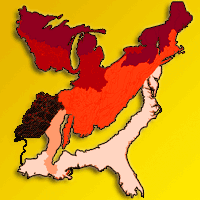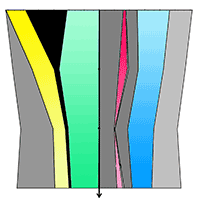
Disassociating tree species associations in the eastern United States
iForest - Biogeosciences and Forestry, Volume 7, Issue 4, Pages 248-254 (2014)
doi: https://doi.org/10.3832/ifor1159-007
Published: Mar 13, 2014 - Copyright © 2014 SISEF
Research Articles
Abstract
Ecologists have a long history of describing species associations including oak-hickory, one of the predominant associations in the eastern United States. But historically, oak composition did not appear particularly related to hickory composition. I assessed the relevance of the oak-hickory association and other associations using older and recent (c. 1981 and 2007) USDA Forest Service surveys. For common hickory and oak species, I determined percent composition (i.e., percent of total stems ≥12.7 cm in diameter, relative density or abundance) in ecological subsections, changes in composition throughout ranges, and compared composition of oaks and hickories and other potential associations using correlation and ordination. Oaks were among the most abundant species while hickories were minor species. Hickory composition was stable while the trajectory of oak continued to decrease during the survey intervals from presettlement dominance. Rank-order correlation between oaks and hickories throughout their ranges was about the maximum as for other species (0.55 and 0.42 during the two survey periods) and in the Oak-Hickory forest region, correlation between oaks and hickories was 0.04 (older surveys) and 0.16 (recent surveys). Oaks were not associated with hickory in the “oak-hickory” forests of Missouri during the mid-1800s, nor were oaks associated with hickory more recently beyond correlations that occur between other eastern forest species. Oak-hickory association in particular is not an informative term for either historical open oak ecosystems or current eastern broadleaf forests. Mixed mesophytic associations, perhaps not best termed as an association, are eastern broadleaf forests where many tree species dominate forested ecosystems in the absence of filtering disturbance. Associations, even if species share similar traits, generally are not strong, stable in time, or extensive in space; differences between species result in different and changing distributions in response to the environment, land use, disease, and other influential factors.
Keywords
Eastern Broadleaf Forests, Mixed Mesophytic, Oak-Hickory, Southern Mixed Forests, Sugar Maple-Beech
Authors’ Info
Authors’ address
University of Missouri, 203 Natural Resources Building, 65211 Columbia, MO (United States of America)
Corresponding author
Paper Info
Citation
Hanberry BB (2014). Disassociating tree species associations in the eastern United States. iForest 7: 248-254. - doi: 10.3832/ifor1159-007
Academic Editor
Marco Borghetti
Paper history
Received: Oct 22, 2013
Accepted: Feb 24, 2014
First online: Mar 13, 2014
Publication Date: Aug 01, 2014
Publication Time: 0.57 months
Copyright Information
© SISEF - The Italian Society of Silviculture and Forest Ecology 2014
Open Access
This article is distributed under the terms of the Creative Commons Attribution-Non Commercial 4.0 International (https://creativecommons.org/licenses/by-nc/4.0/), which permits unrestricted use, distribution, and reproduction in any medium, provided you give appropriate credit to the original author(s) and the source, provide a link to the Creative Commons license, and indicate if changes were made.
Web Metrics
Breakdown by View Type
Article Usage
Total Article Views: 54473
(from publication date up to now)
Breakdown by View Type
HTML Page Views: 46792
Abstract Page Views: 2640
PDF Downloads: 3515
Citation/Reference Downloads: 18
XML Downloads: 1508
Web Metrics
Days since publication: 4302
Overall contacts: 54473
Avg. contacts per week: 88.64
Citation Metrics
Article Citations
Article citations are based on data periodically collected from the Clarivate Web of Science web site
(last update: Mar 2025)
Total number of cites (since 2014): 1
Average cites per year: 0.08
Publication Metrics
by Dimensions ©
Articles citing this article
List of the papers citing this article based on CrossRef Cited-by.
References
Silvics of North America: 2. Hardwoods. Agriculture Handbook 654, USDA Forest Service, Washington, DC, USA, pp. 877.
Gscholar
National hierarchical framework of ecological units. Ecoregions of the United States (map, revised edn), Scale 1:7500000 colored, unpublished administrative paper, USDA Forest Service, Washington, DC, USA, pp. 20.
Gscholar
Historical and ecological roles of disturbance in eastern North American forests: 9.000 years of change. Wildlife Society Bulletin 29: 425-439.
Gscholar
The vegetation of Connecticut III. Plant societies on uplands. Torreya 14: 167-194.
Gscholar
The primary plant associations of Ohio: their distribution and their significance as habitat indices. Ohio Journal of Science 27: 301-310.
Gscholar
Approaches to classifying vegetation. In: “Classification of Plant Communities” (Whittaker RH ed). Dr W. Junk B. V. Publishers, The Hague, Boston, USA, pp. 1-32.
Gscholar

















